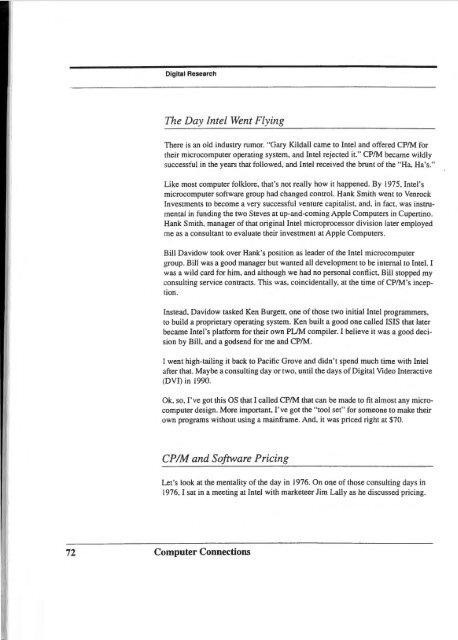appreciate
kildall-p.1-78-publishable-lowres
kildall-p.1-78-publishable-lowres
Create successful ePaper yourself
Turn your PDF publications into a flip-book with our unique Google optimized e-Paper software.
Digital Research<br />
The Day Intel Went Flying<br />
There is an old industry rumor. "Gary Kildall came to Intel and offered CP/M for<br />
their microcomputer operating system, and Intel rejected it." CP/M became wildly<br />
successful in the years that followed, and Intel received the brunt of the "Ha. Ha's."<br />
Like most computer folklore, that's not really how it happened. By 1975, Intel's<br />
microcomputer software group had changed control. Hank Smith went to Venrock<br />
Investments to become a very successful venture capitalist, and. in fact. was instrumental<br />
in funding the two Steves at up-and-coming Apple Computers in Cupertino.<br />
Hank Smith. manager of that original Intel microprocessor division later employed<br />
me as a consultant to evaluate their investment at Apple Computers.<br />
Bill Davidow took over Hank's position as leader of the Intel microcomputer<br />
group. Bill was a good manager but wanted all development to be internal to Intel. I<br />
was a wild card for him, and although we had no personal conflict, Bill stopped my<br />
consulting service contracts. This was, coincidentally, at the time of CP/M's inception.<br />
Instead, Davidow tasked Ken Burgett, one of those two initial Intel programmers,<br />
to build a proprietary operating system. Ken built a good one called ISIS that later<br />
became Intel's platform for their own PIJM compiler. I believe it was a good decision<br />
by Bill, and a godsend for me and CP/M.<br />
I went high-tailing it back to Pacific Grove and didn't spend much time with Intel<br />
after that. Maybe a consulting day or two, until the days of Digital Video Interactive<br />
(DVI) in 1990.<br />
Ok, so, I've got this OS that I called CP/M that can be made to fit almost any microcomputer<br />
design. More important, I've got the "tool set" for someone to make their<br />
own programs without using a mainframe. And, it was priced right at $70.<br />
CPIM and Software Pricing<br />
Let's look at the mentality of the day in 1976. On one of those consulting days in<br />
1976, I sat in a meeting at Intel with marketeer Jim Lally as he discussed pricing.<br />
72<br />
Computer Connections


